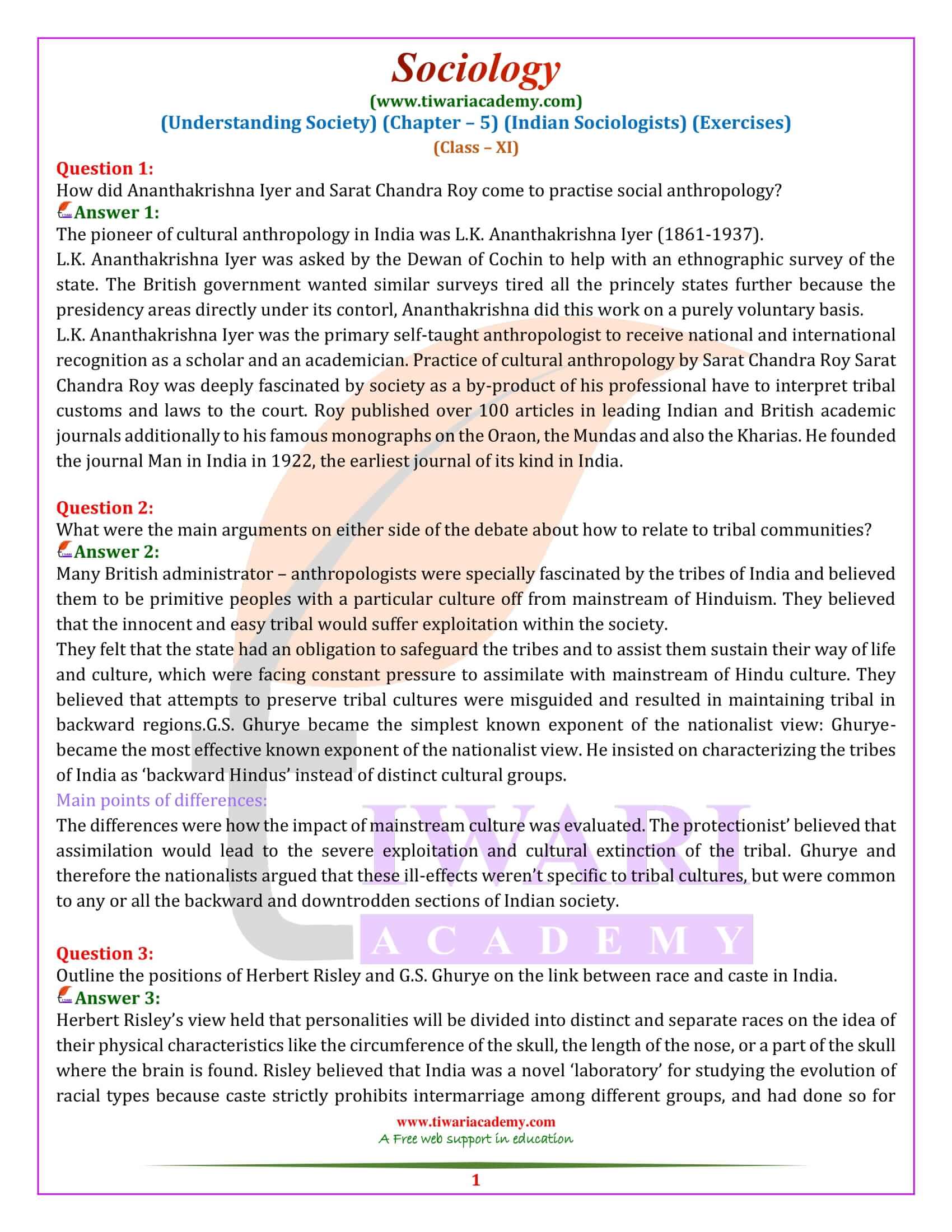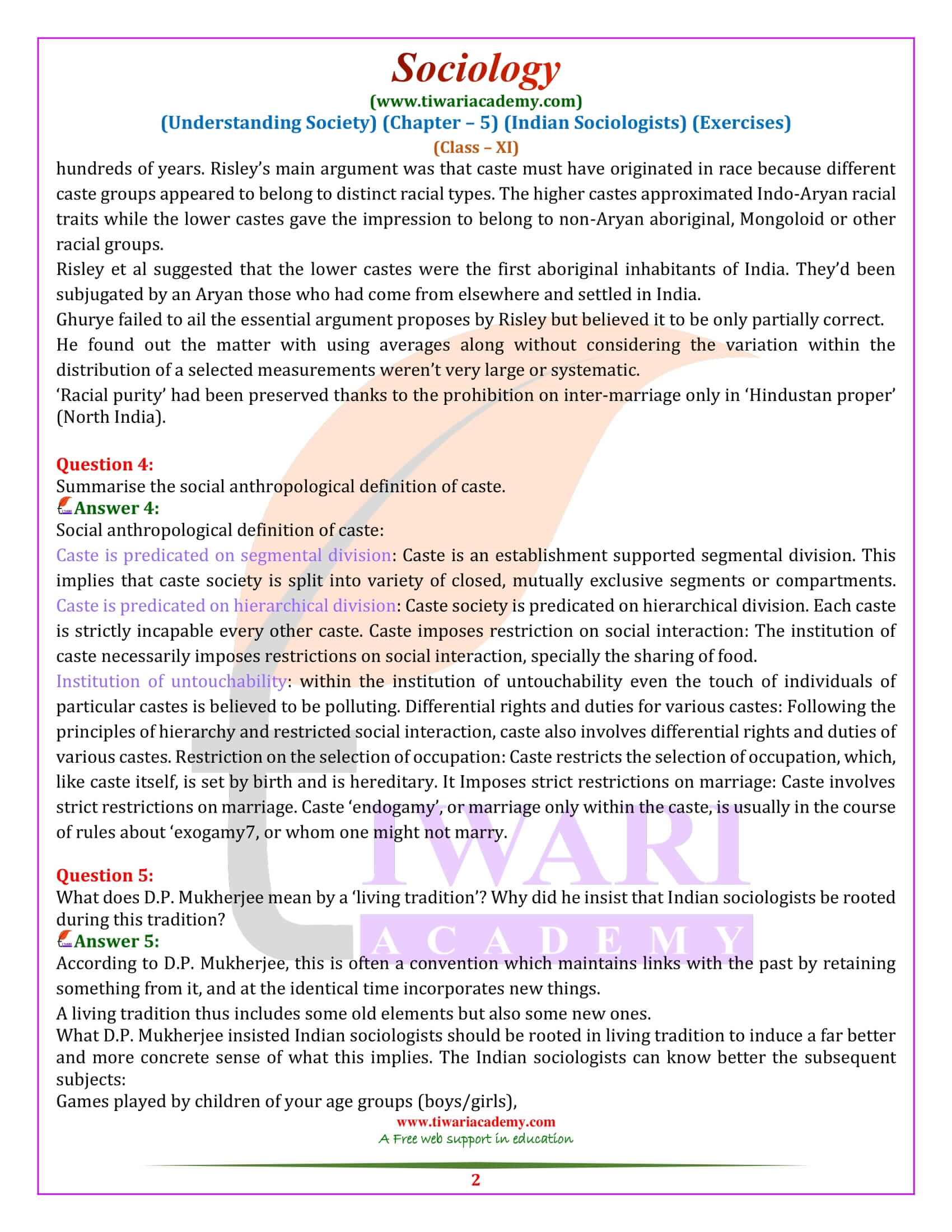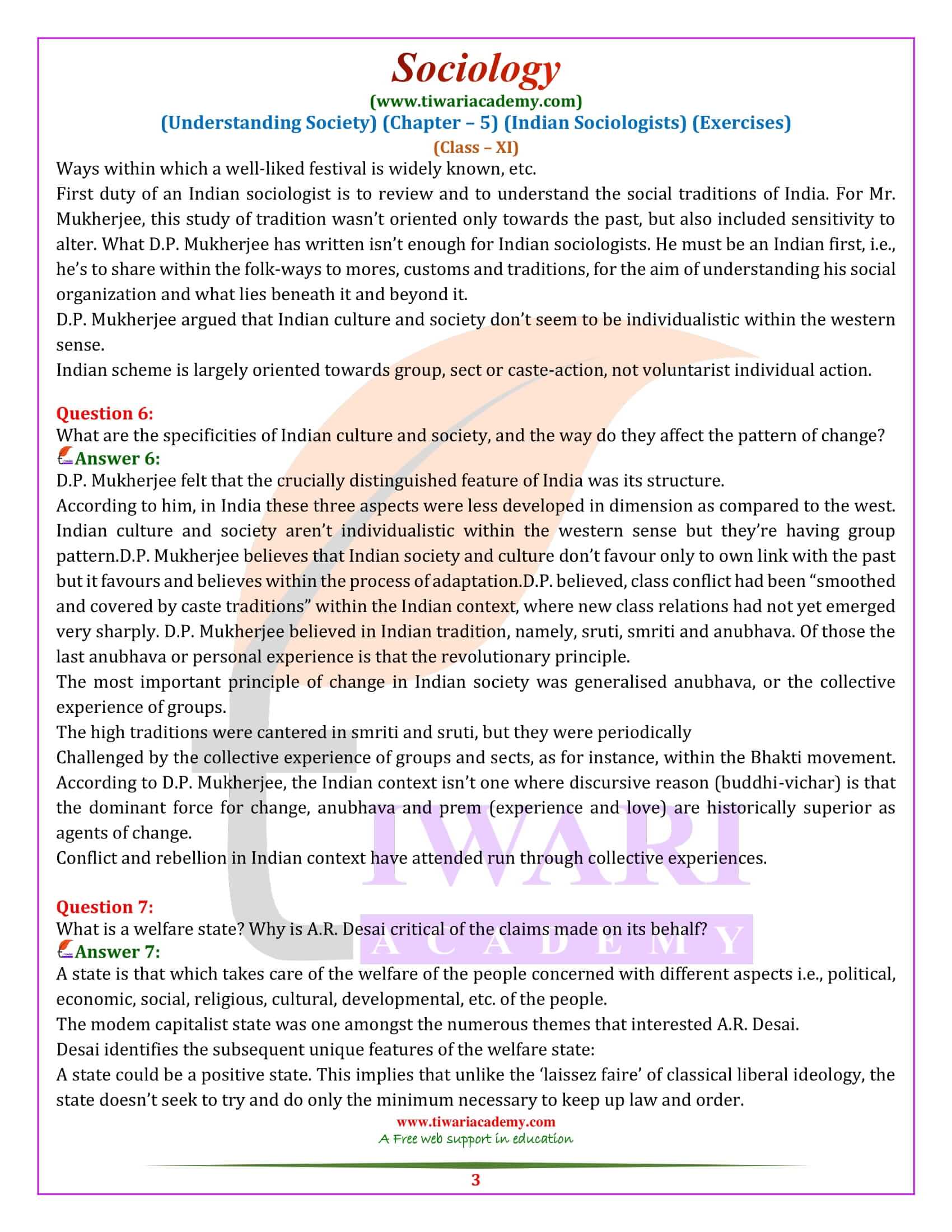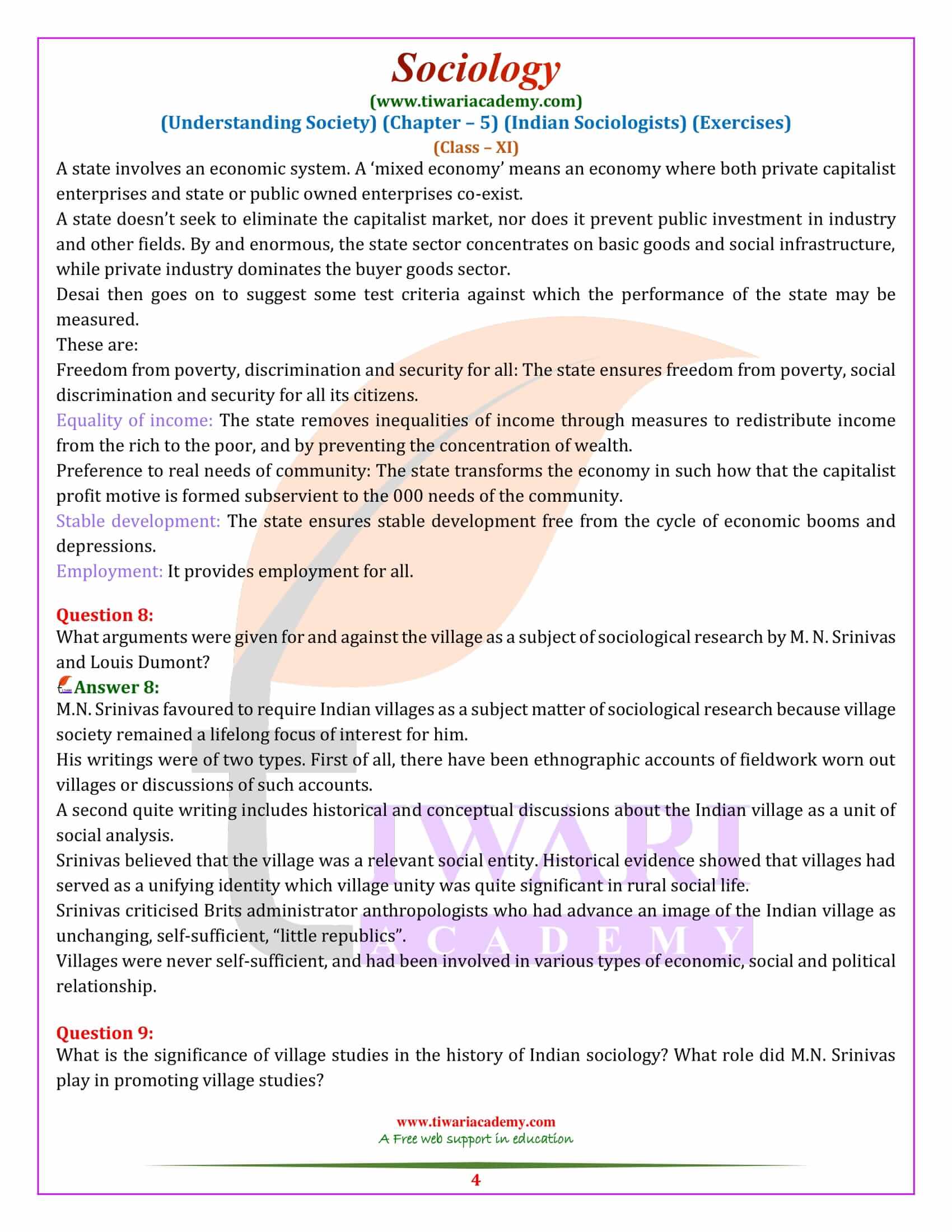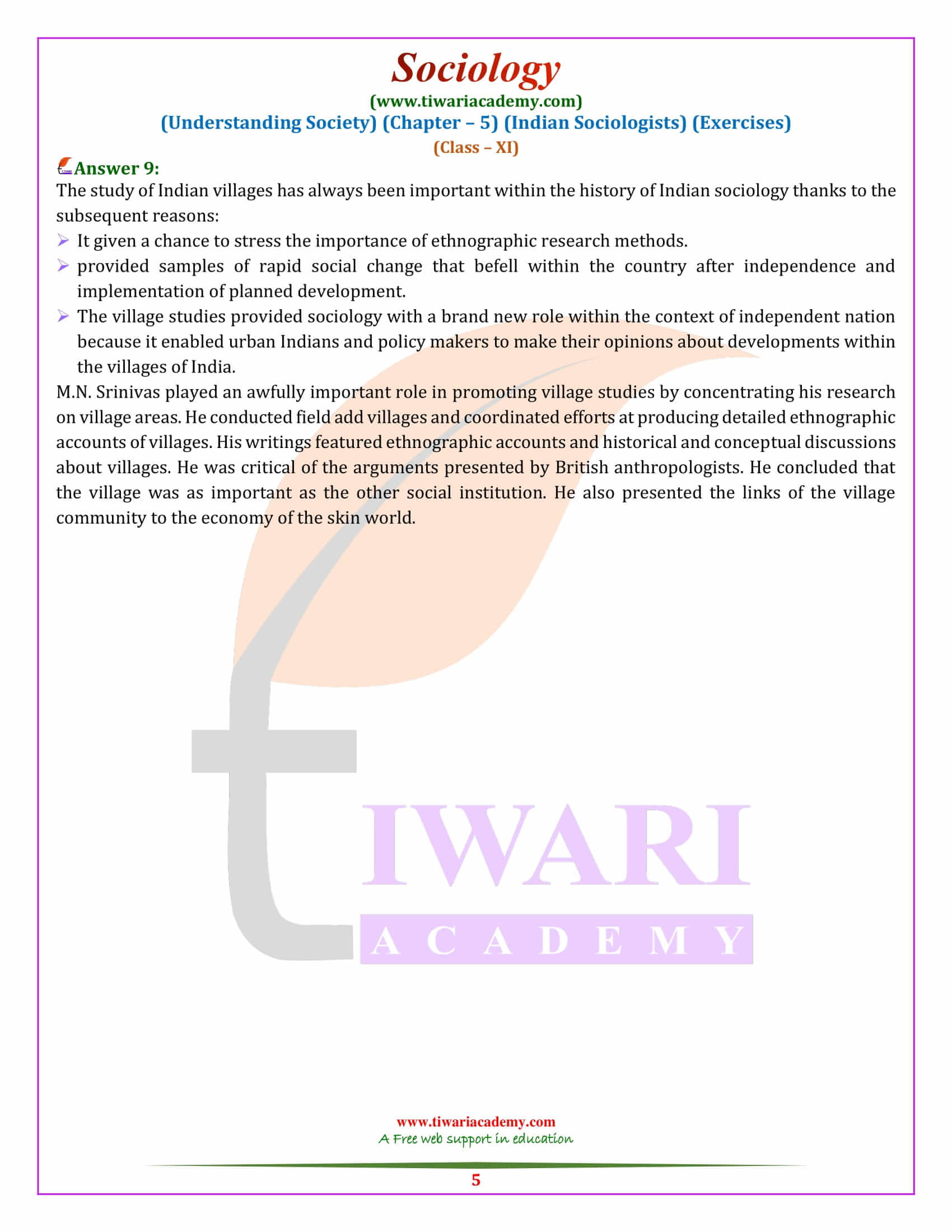NCERT Solutions for Class 11 Sociology Chapter 5 Indian Sociologists updated for new academic session 2024-25. Get all the question answers with multiple choice questions of 11th Sociology Part II Understanding Society chapter 5 with solution and explanation.
Class 11 Sociology Chapter 5 Indian Sociologists Question Answers
How did Ananthakrishna Iyer and Sarat Chandra Roy come to practise social anthropology?
The pioneer of cultural anthropology in India was L.K. Ananthakrishna Iyer (1861-1937).
L.K. Ananthakrishna Iyer was asked by the Dewan of Cochin to help with an ethnographic survey of the state. The British government wanted similar surveys tired all the princely states further because the presidency areas directly under its contorl, Ananthakrishna did this work on a purely voluntary basis.
L.K. Ananthakrishna Iyer was the primary self-taught anthropologist to receive national and international recognition as a scholar and an academician. Practice of cultural anthropology by Sarat Chandra Roy Sarat Chandra Roy was deeply fascinated by society as a by-product of his professional have to interpret tribal customs and laws to the court. Roy published over 100 articles in leading Indian and British academic journals additionally to his famous monographs on the Oraon, the Mundas and also the Kharias. He founded the journal Man in India in 1922, the earliest journal of its kind in India.
What were the main arguments on either side of the debate about how to relate to tribal communities?
Many British administrator – Anthropologists were specially fascinated by the tribes of India and believed them to be primitive peoples with a particular culture off from mainstream of Hinduism. They believed that the innocent and easy tribal would suffer exploitation within the society.
They felt that the state had an obligation to safeguard the tribes and to assist them sustain their way of life and culture, which were facing constant pressure to assimilate with mainstream of Hindu culture. They believed that attempts to preserve tribal cultures were misguided and resulted in maintaining tribal in backward regions.G.S. Ghurye became the simplest known exponent of the nationalist view: Ghurye-became the most effective known exponent of the nationalist view. He insisted on characterizing the tribes of India as ‘backward Hindus’ instead of distinct cultural groups.
Main points of differences:
The differences were how the impact of mainstream culture was evaluated. The protectionist’ believed that assimilation would lead to the severe exploitation and cultural extinction of the tribal. Ghurye and therefore the nationalists argued that these ill-effects weren’t specific to tribal cultures, but were common to any or all the backward and downtrodden sections of Indian society.
Outline the positions of Herbert Risley and G.S. Ghurye on the link between race and caste in India.
Herbert Risley’s view held that personalities will be divided into distinct and separate races on the idea of their physical characteristics like the circumference of the skull, the length of the nose, or a part of the skull where the brain is found. Risley believed that India was a novel ‘laboratory’ for studying the evolution of racial types because caste strictly prohibits intermarriage among different groups, and had done so for hundreds of years. Risley’s main argument was that caste must have originated in race because different caste groups appeared to belong to distinct racial types. The higher castes approximated Indo-Aryan racial traits while the lower castes gave the impression to belong to non-Aryan aboriginal, Mongoloid or other racial groups.
Risley et al suggested that the lower castes were the first aboriginal inhabitants of India. They’d been subjugated by an Aryan those who had come from elsewhere and settled in India.
Ghurye failed to ail the essential argument proposes by Risley but believed it to be only partially correct.
He found out the matter with using averages along without considering the variation within the distribution of a selected measurements weren’t very large or systematic.
‘Racial purity’ had been preserved thanks to the prohibition on inter-marriage only in ‘Hindustan proper’ (North India).
What does D.P. Mukherjee mean by a ‘living tradition’? Why did he insist that Indian sociologists be rooted during this tradition?
According to D.P. Mukherjee, this is often a convention which maintains links with the past by retaining something from it, and at the identical time incorporates new things.
A living tradition thus includes some old elements but also some new ones.
What D.P. Mukherjee insisted Indian sociologists should be rooted in living tradition to induce a far better and more concrete sense of what this implies. The Indian sociologists can know better the subsequent subjects:
Games played by children of your age groups (boys/girls),
Ways within which a well-liked festival is widely known, etc.
First duty of an Indian sociologist is to review and to understand the social traditions of India. For Mr. Mukherjee, this study of tradition wasn’t oriented only towards the past, but also included sensitivity to alter. What D.P. Mukherjee has written isn’t enough for Indian sociologists. He must be an Indian first, i.e., he’s to share within the folk-ways to mores, customs and traditions, for the aim of understanding his social organization and what lies beneath it and beyond it.
D.P. Mukherjee argued that Indian culture and society don’t seem to be individualistic within the western sense.
Indian scheme is largely oriented towards group, sect or caste-action, not voluntarist individual action.
What arguments were given for and against the village as a subject of sociological research by M. N. Srinivas and Louis Dumont?
M.N. Srinivas favoured to require Indian villages as a subject matter of sociological research because village society remained a lifelong focus of interest for him.
His writings were of two types. First of all, there have been ethnographic accounts of fieldwork worn out villages or discussions of such accounts.
A second quite writing includes historical and conceptual discussions about the Indian village as a unit of social analysis.
Srinivas believed that the village was a relevant social entity. Historical evidence showed that villages had served as a unifying identity which village unity was quite significant in rural social life.
Srinivas criticised Brits administrator anthropologists who had advance an image of the Indian village as unchanging, self-sufficient, “little republics”.
Villages were never self-sufficient, and had been involved in various types of economic, social and political relationship.
